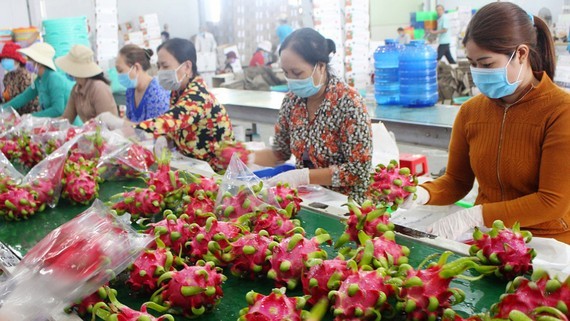 The agriculture sector in Mekong Delta supports farmers in finding markets
The agriculture sector in Mekong Delta supports farmers in finding markets
According to the Department of Agriculture and Rural Development of Can Tho City, up to now, the city has more than 23,500 hectares of fruit trees, with an output of more than 168,250 tons annually. Many areas of orchards help farmers achieve a profit of VND200 million - VND800 million per ha annually, even higher.
The types of fruit trees grown in Can Tho City are quite diverse in types, including many delicious and specialty fruit trees such as durian, breast milk, longan, orange, grapefruit, and Ha Chau strawberry with high economic value.
Can Tho City has also established many concentrated fruit-growing areas such as durian and Ha Chau strawberry growing areas in Phong Dien District, longan in O Mon and Thoi Lai districts and mango area in Co Do District.
Simultaneously, the agriculture sector takes heed of collective trademark building for many kinds of fruit trees such as mango orange and Idol longan in Thoi An Ward in O Mon District, Ha Chau strawberry in Nhon Ai Commune in Phong Dien District, durian in Tan Thoi commune and Truong Khuong A in Truong Long Commune in Phong Dien District; thereby, contributing to improving the value of products associated with consumption, increasing competitive advantage, associated with the development of ecological tourism.
Mr. Nguyen Van Su, Director of the Department of Agriculture and Rural Development of Can Tho City, said that the agricultural sector is orienting and supporting farmers to develop specialized fruit tree areas with high economic value.
At the same time, the sector is focusing on improving quality, building brands, and expanding effective models of orchards such as durian, breast milk, longan, Hoa Loc and mango. Moreover, the sector has strengthened the linkages and coordination with units and businesses to build brands for fruits and promote processing and preserving after harvest. Thanks to the sector’s efforts, over the past time, many fruits of Can Tho City have been successfully exported to difficult markets, especially Europe.
Long An Province has so far more than 17,800ha of dragon fruit, mango, watermelon, banana, and lemon. Amongst which, 213 planting areas have been granted codes for export to markets like Australia, New Zealand, the United States, South Korea and China.
Director of the Sub-Department of Cultivation, Plant Protection and Quality Control of Agricultural Products in Long An Province Nguyen Van Cuong said that in order to strictly manage the planting area codes, the province has provided training courses and guidance to farmers and cooperatives on the processes of building and effectively using the planting area codes.
According to the Department of Industry and Trade of Long An Province, over the past time, the province has held sessions on exporting dragon fruits to Australia and New Zealand. With more than 11,820ha, dragon fruit is Long An’s main export of fresh and frozen fruit to many markets; amongst them, the Chinese market accounts for about 80 percent of the export volume.
In addition to consuming and exporting fresh fruit, enterprises in Long An Province also make drying crispy, drying plastic, wine, juice, soluble powder, and syrup for domestic demand and export. Chau Thanh dragon fruit in Long An Province was granted a certificate of geographical indication registration by the National Office of Intellectual Property. Tam Vu dragon fruit trademark is protected in five countries comprising the United States, France, Japan, Singapore and China. Long An also has a fruit processing plant with hot steam technology, with a capacity of 12,000 tons a year, and is eligible for packaging for export to some markets with high-quality requirements.
Authorities in Tien Giang Province are preparing to deploy and operate an e-commerce application project in connecting consumption, fruit processing and building software for the online distribution of agricultural products. At the same time, authorities have given support to businesses in market information, export promotion, participation in fairs, conferences to connect supply and demand, and international-scale events to businesses to help businesses to access market and export partners.
According to Mr. Le Thanh Tung, Deputy Director of the Department of Crop Production under the Ministry of Agriculture and Rural Development, Vietnam’s fruit processing capacity is still limited whereas it mainly exports fresh fruit, so if there are bottlenecks for export, sales of fresh fruits will be affected.
Subsequently, in the long term, it is necessary to reorganize production in the direction of increasing quality, reducing costs, increasing deep processing, and expanding consumption markets through strengthening linkages between stakeholders in the fruit production chain to be more closely linked with market demand.
























